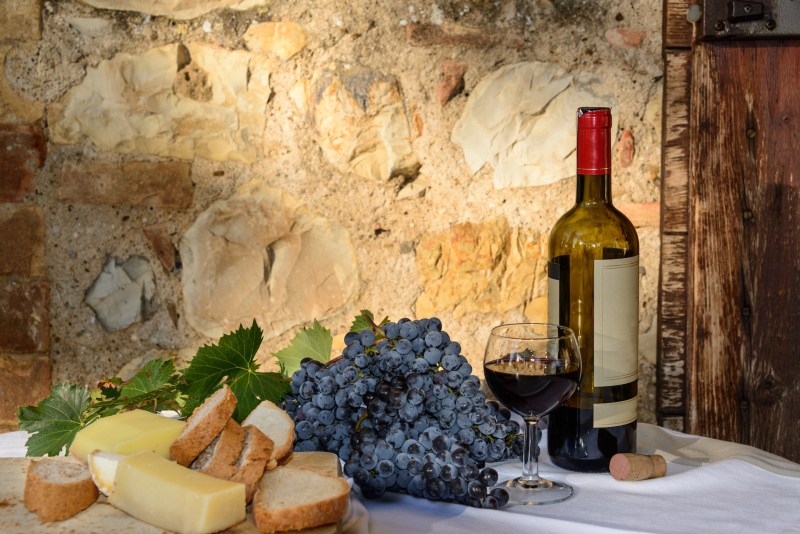
When one thinks of Italy, wine is one of the first images that comes to mind. In addition to the lush, sweeping landscapes, the watery canals twinkling with romantic gondolas, and the heavenly food that is no doubt what the angels themselves feast upon, wine is very much at the top of that list. Apart from the romanticism of wine itself, which automatically groups it into all things Italian, Italian wine is actually nothing short of spectacular.
My personal favorite Italian varietal is Sangiovese. It’s the bottle I order at every Italian restaurant I visit, and it’s a decision I’ve never once regretted. This delicious varietal has been part of Italian culture and has quite an interestingly colorful history attached to its name. The direct translation of Sangiovese is “blood of Jove,” referring to the Roman god, Jupiter. Legend states that Roman monks named this wine as a tribute to the god, suggesting that this is the wine that flowed through Jupiter’s veins. For me, this legend alone is reason enough to love this particular varietal, but it just so happens to be incredibly delicious, even without the cool story.
Sangiovese wine is dry, medium-bodied, red Italian wine with a high acid content and considerable – but not greedy – tannins. To offset Sangiovese’s high acidity, it is often blended with milder red grapes such as Canaiolo, Merlot, and Cabernet Sauvignon. Though many, myself included, prefer 100% Sangiovese wines.
Interestingly, Chianti – arguably Italy’s most famous wine – is made from Sangiovese grapes that come from Italy’s Chianti wine region. While not all Sangiovese is from Chianti, all wine with a “Chianti” label is made from Sangiovese grapes.
Primary flavors of Sangiovese

Sangiovese primarily boasts flavors of deep, rich fruit such as cherry, plum, fig, and blackberry. Second on the nose are typically notes of dried herbs, leather, tobacco, smoke, and dark coffee. Earthier varieties can also flirt with flavors like moss and mushroom.
The taste profile of Sangiovese

A true dry red wine, Sangiovese lacks much residual sugar, resulting in its firm tannins and high acidity levels. The alcohol level of Sangiovese ranges from about 13 – 14% ABV, falling into the same general category as most table wines.
Where does Sangiovese grow?

Sangiovese is almost strictly an Italian-grown wine. Sangiovese is Italy’s most popular grape, native to Tuscany, but also thrives in other Italian regions such as Umbria, Campania, and Romagna.
Of course, other locations around the world, like Mendoza, Argentina, and Napa, do grow Sangiovese, though this special variety is primarily Italian-grown.
How to serve Sangiovese

Sangiovese’s pronounced tannins and elevated acidity levels need considerable time to breathe before serving and should be decanted for at least an hour, preferably two, before it’s time to pour. Serve Sangiovese at a temperature between 55 and 65 degrees Fahrenheit.
This versatile wine is subtle enough to be enjoyed on its own but pairs beautifully with an Italian-themed charcuterie board topped with cured meats and hard cheeses. Fruits like figs, cherries, peaches, and strawberries will also help to bring out the fruity flavors in the wine.
Which foods pair best with Sangiovese

If your menu is even thinking about leaning in an Italian direction, Sangiovese is the wine to select. This beautiful red will make all of your favorite Italian dishes sing, including pizza, pasta, tomato-based sauces, mushrooms, truffles, risottos, and every single beautifully Italian cured meat like prosciuttos and salamis. There isn’t a single Italian dish or ingredient that isn’t improved by a bottle (or two) of this delicious wine.
Sangiovese’s strong tannins also make this beautiful wine ideal for pairing with fatty cuts of beef, pork, and lamb.
Frequently asked questions

We’ve researched some of the most commonly asked questions about Sangiovese, so you don’t have to.
Is Sangiovese sweet or dry?
Sangiovese is a true dry wine. While it can be fruity in flavor, with deep, rich notes of red fruits, it is tannic and does not contain a great deal of residual sugar. Of course, some may interpret Sangiovese’s fruity flavors as sweet and can therefore be described as such, depending on the bottle.
Is Sangiovese the same as Pinot Noir?
Sangiovese and Pinot Noir are very comparable wines in that both varietals take on their terroir beautifully well. Though there is no genetic link between these two varietals, both are medium-bodied, highly acidic red wines that can complement and pair perfectly with a wide range of dishes.
What is Sangiovese comparable to?
While every wine variety has its own special characteristics, Sangiovese’s medium body and tannin level can be compared to varieties such as Pinot Noir, Merlot, and Brunello.



